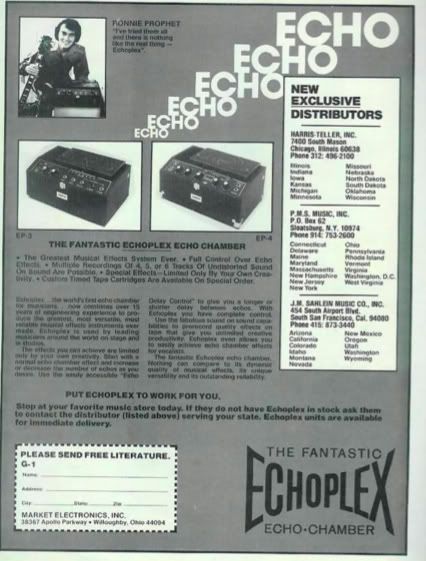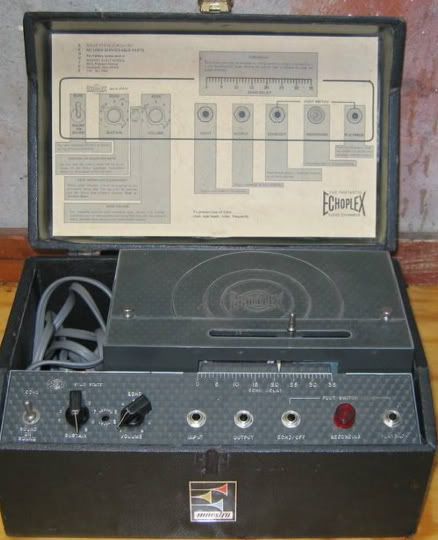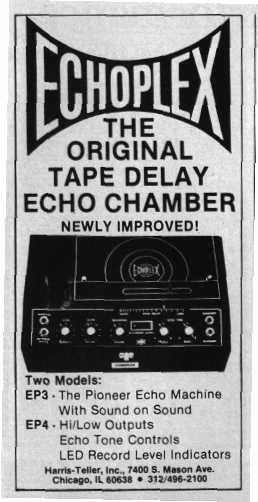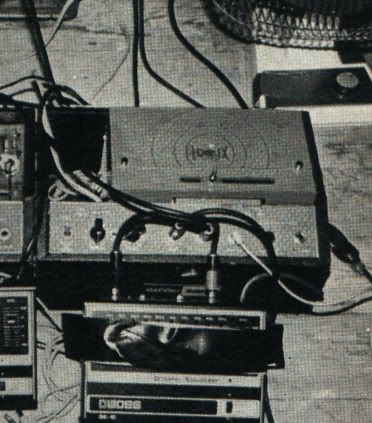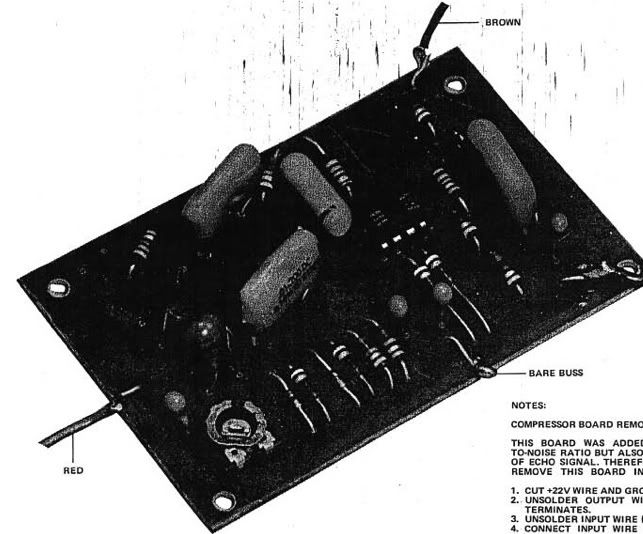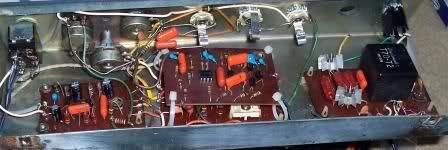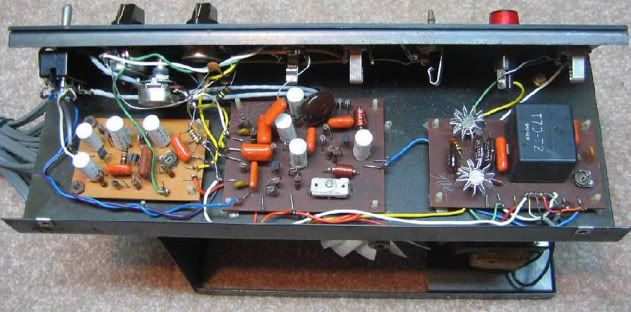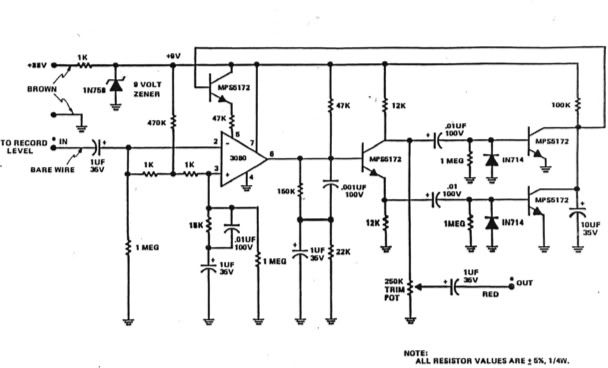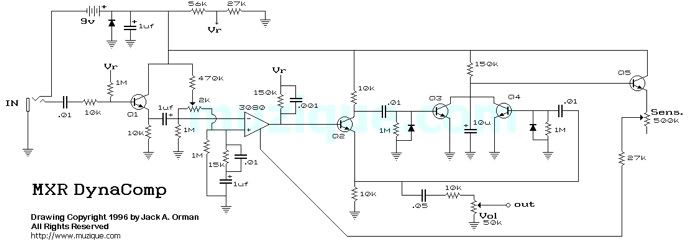Ed seems to have bought his EP-3 in early 1977 new, because of the wide "Maestro Echoplex" logo on his Echoplex.
From the few photos we have, Ed had the newer wide "Maestro Echoplex" logo on his Echoplex in the end of May 1977 Mumps photo so obviously he bought it before then.
The previous Echoplexes just had a smaller Maestro logo.
The EP-4 was introduced around early 1977 and I think these EP-4's were the main reason for the new wide "Maestro Echoplex" logo and the EP-3's also got the new wide "Maestro Echoplex" logo at the same time as the EP-4.
They were selling EP-3's and EP-4's together for a while.
What's interesting about the EP-4 and EP-3 in early 1977 when it seems that Ed bought his EP-3 is that the EP-4 and also the EP-3 had compressor boards installed for a while.
These Echoplex compressor board circuits are based on an engineer hooking up a compressor stompbox to the Echoplex record circuit for testing purposes.
The compressor stompbox that was used looks to have been a MXR Dyna-Comp judging from the Echoplex Compressor board schematic because the Echoplex Compressor board and the MXR Dyna-Comp schematics are just about identical, same chip etc.
The Echoplex compressors output setting is adjusted by a trim pot and the sensitivity value is fixed to a certain setting.
The compressor boards were apparently incorrectly installed (maybe) and the compression ended up not just on the Echoplex wet record signal but also on the Echoplex dry signal due to a misunderstanding of the engineers plans.
After the EP-3's and EP-4's had been shipped with the compressor for a while, the compressor board being installed on the dry signal mistake was realized and the engineer tried to have the compressor installed just on the record wet signal for further Echoplexes but I think the Echoplex owner lost interest and scrapped it.
Ed seems to have bought his EP-3 Echoplex around the time when they were being sold with compressor boards and these EP-3 Echoplexes are really EP-3 Echoplexes with a MXR Dyna-Comp installed probably at the input.
Also it seems like the chicken knob EP-3's with the wider B&W "Maestro Echoplex" logos stand a good chance of being compressor board EP-3's because the chicken knobs changed to the other design knobs sometime in 1977 (going by the 1977 Echoplex ad) and the wider B&W "Maestro Echoplex" logo comes in in late 1976/early 1977, so the chicken knob wider B&W "Maestro Echoplex" logo EP-3's would be the late 1976/early 1977 EP-3's that were coming with compressor boards.
Ed's EP-3's are the chicken knob wider B&W "Maestro Echoplex" logo EP-3's.
1: Ed has a wider B&W "Maestro Echoplex" logo EP-3 that was introduced in late 1976/early 1977.
2: Ed's EP-3(s) have the earlier chicken knobs and the newer wider B&W "Maestro Echoplex" logo dating Ed's EP-3's to late 1976/early 1977 EP-3's.
3: Compressor boards were being installed in the late 1976/early 1977 EP-3's and also in the newly introduced late 1976/early 1977 EP-4's.
4: Ed buys his wider B&W "Maestro Echoplex" logo EP-3(s) new sometime in early 1977.
So there it is, maybe something in it.
Whether someone thinks Ed had a compressor board EP-3 or not depends on their ears I suppose.
This dude has a EP-3 with a compressor board.
It has the extra compressor board on the top of the other boards.
It's a EP-3 with a older smaller Maestro logo that is before the 1977 logo change to a wider "Maestro Echoplex" logo and seeing that the compressor boards were mostly installed in the newer wider "Maestro Echoplex" logo EP-3's and EP-4's in 1977, this compressor board EP-3 with the older smaller Maestro logo must be pretty close to when the logo change happened in late 1976/early 1977, so I'm guessing it's from late 1976 just before the logo change.
Ed's early 1977 EP-3(s) are the wider"Maestro Echoplex" logo EP-3's when they had compressor boards installed.
He gives a bit of a clean demo of it in part 1 and at the end of part 2.
Don't know about anyone else, but to me it sounds pretty good with the compressor board, so I don't really know why some dudes around the net would want to remove the compressor board.
[youtube]http://www.youtube.com/watch?v=qWpj85HN7H4[/youtube]
[youtube]http://www.youtube.com/watch?v=h5uH6y7yWOI[/youtube]
--------------------------------------------------------------------------------------------------------
The Echoplex logos are in the Echoplex Ads from various years.
The Echoplexes with just a small Maestro logo are pre 1977.
The Echoplexes with a wider "Maestro Echoplex" logo are from 1977 and 1978.
The Echoplexes with just a small "Echoplex" logo are from 1979 until the end of the Echoplexes.
Ed's Echoplexes have the wider "Maestro Echoplex" logo that seems to have been introduced with the release of the Echoplex EP-4 model around early 1977 and the EP-3 model also seemed to change to the wider "Maestro Echoplex" at the same time to be in line with the new wider "Maestro Echoplex" logo that the EP-4 had.
Both the EP-3 and EP-4 models were fitted with compressor boards around the time that the EP-4 was introduced and this also seems to be the time when the EP-3 logo switched to the wider "Maestro Echoplex" logo.
So Ed could have bought his EP-3's new and at around the time when they were being fitted with compressor boards as Ed already has a wider "Maestro Echoplex" logo Echoplex in the end of May 1977 Mumps Whisky photo.
End of May 1977 Mumps Whisky photo with Ed's Echoplex having the wider "Echoplex Maestro" logo

Ed's Echoplex with wider "Echoplex Maestro" logo

Small "Maestro" logo
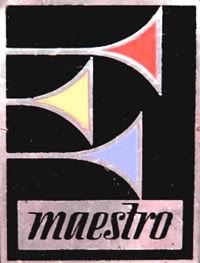
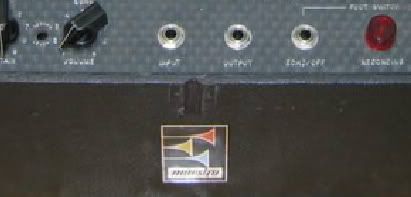
Wider "Maestro Echoplex" logo

Later small "Echoplex" logo

Echoplex 1972 Ad
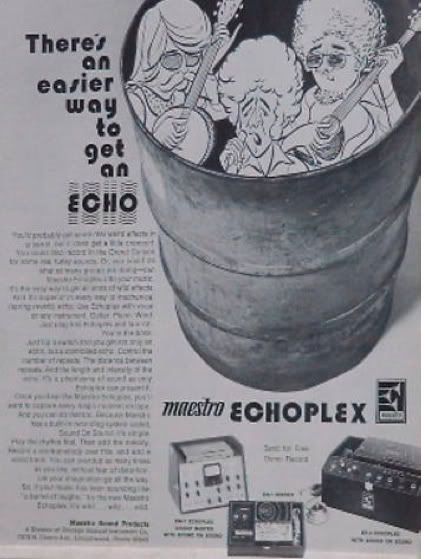
Echoplex 1973 Ad
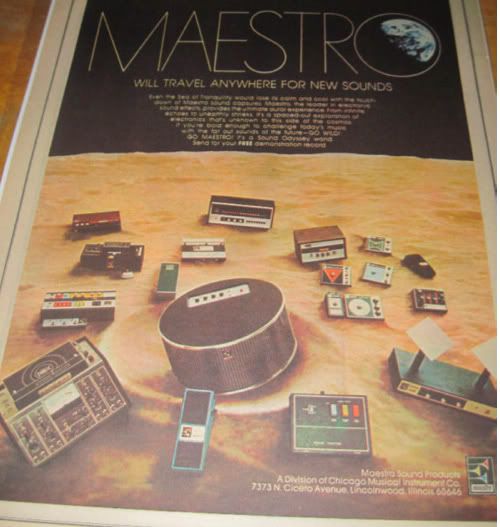
Echoplex 1975 Ad
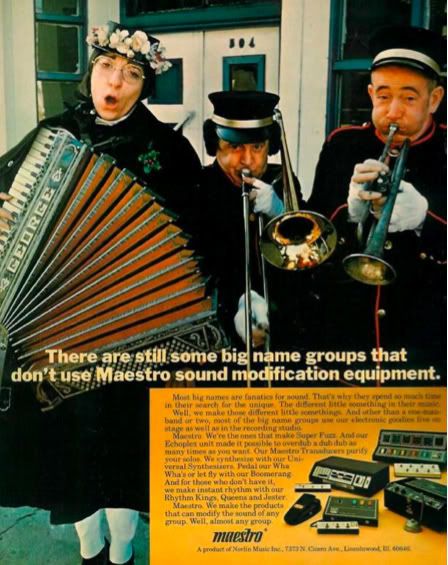
1976 Echoplex with the smaller Maestro logo that this dude bought new in 1976.
The logo change to the wider B&W "Echoplex Maestro" logo had not happened yet.
[youtube]http://www.youtube.com/watch?v=R651lfBhngo[/youtube]
This is the 1977 Ed logo change.
The EP-4 was introduced with the new wider B&W "Echoplex Maestro" logo change in late 1976/early 1977 and had compressor boards.
The EP-3 was also installed with compressor boards at the same time as the EP-4 and some older smaller "Maestro" logo EP-3 backstock got the compressor board installed for sale in 1977 (EP-3 older logo older stock transition period to newer logo, EP-4 has no transition period and is introduced with the new logo) but the EP-3 generally changes to a wider "Echoplex Maestro" logo in late 1976/early 1977 exactly the same as the EP-4 and this is Ed's early 1977 EP-3 wider "Echoplex Maestro" logo.
Chicken knobs are used on the early wider B&W "Echoplex Maestro" logo EP-3's and EP-4's in late 1976/early 1977 (compressor board EP-3's and EP-4's) and then they change the knobs to a new design sometime in 1977 (see Echoplex 1977 ad).
Ed's EP-3's have chicken knobs and the new wider B&W "Echoplex Maestro" logo indicating that Ed's EP-3's are from late 1976/early 1977 and this was when the compressor boards were being installed into EP-3's and EP-4's.
"EP-4 (late 70s): Around 1976-’77, the Market Electronics/Norlin team introduced another model, without S.O.S., but having bass and treble controls for the echo signal."
http://www.vintageguitar.com/1964/echoplex/" onclick="window.open(this.href);return false;
Echoplex 1977 Ad

Echoplex 1978 Ad
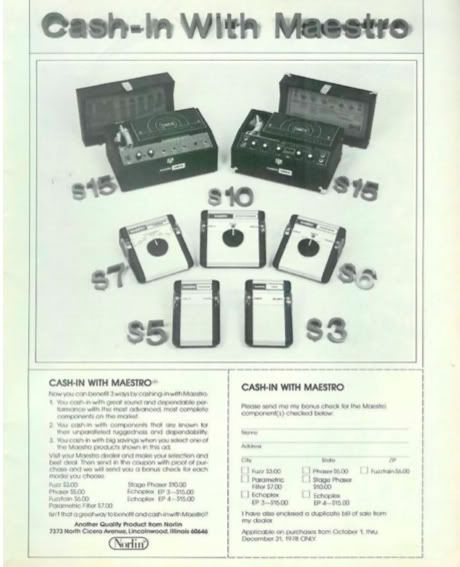
Echoplex 1979 Ad
